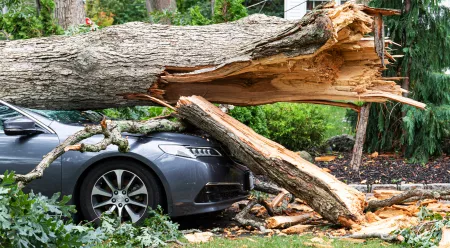Home insurance coverage protects against many common risks. However, there’s no one-size-fits-all policy. Keep reading to learn more about what home insurance does and doesn’t cover by default.
What Does Home Insurance Cover?
Home insurance protects you from the financial fallout of damage to your home and personal belongings. It’s an important tool for mitigating the ever-present risk of fires, storms, break-ins, and other unfortunate events that could otherwise devastate you financially.
Let’s take a closer look at these common coverages. Read our article for more information on how a home security system can help you save on your overall cost.
Dwelling Coverage
Dwelling coverage applies to your home’s structure, including its walls, roof, and foundation. If these components are damaged – or even completely destroyed – in an incident that falls under your home insurance coverage, your provider can help you foot the bill.
That may include paying for repairs or, in the event of a total loss, writing a check for your home’s replacement value.
Incidents covered by basic home insurance policies typically include:
- Vehicular impacts (including aircraft)
- Explosions
- Falling objects
- Theft
- Smoke
- Fire
- Vandalism
- Rioting
- Water damage
- Hail
Other Property Coverage
Other property coverage applies to structures on your property that are not a physical part of your home. This would include, for example, a deck or detached garage. Check also this post about co-op home insurance.
Contents Coverage
Of course, your home isn’t just a structure. It contains valuable belongings. Thankfully, home insurance coverage extends to many – but not all; more on this shortly – of these items. If a covered incident results in these belongings being damaged or lost, your home insurance policy can help with associated costs. One aspect of home insurance that isn't always clear is the process of events surrounding a theft outside the home.
Home Insurance Liability Coverage
Home insurance liability coverage protects you in the event that a guest gets hurt on your property and pursues you for damages.
If someone falls down the stairs and suffers an injury requiring expensive physiotherapy, for example, home insurance liability coverage can prevent you from having to pay out of pocket if you’re determined to be at fault.
Living Expense Coverage
In the event that damage to your home requires you to vacate the property, living expense coverage will help you foot the bill for alternate accommodations (i.e. booking a hotel, purchasing meals you would’ve otherwise cooked at home, etc).
What Doesn’t Home Insurance Cover?
Now that you know what home insurance covers, let’s look at what it doesn’t. In many cases, you can pay extra for these coverages, which we’ll also discuss.
Extraordinarily Expensive Belongings
While home insurance coverage protects most personal belongings, that does not automatically apply to extraordinarily expensive items.
Standard home insurance policies come with around $40,000 of contents coverage. This may not be enough to cover the cost of replacing an expensive jewelry collection, for example. Without extended coverage, you’d be out of luck if you ever needed to file a claim for those items.
Thankfully, extended coverage is fairly easy to obtain. It involves purchasing scheduled personal property coverage amounting to the appraised value of your expensive items.
Floodwater
While standard home insurance policies protect against water damage, this typically only applies to plumbing issues. Natural floodwater, on the other hand, is generally excluded. If you live in a flood-prone area, you’ll want to check for flooding specific coverage.
Earth Movements
Earth movements are another natural disaster not typically covered by basic home insurance policies. This includes damage caused by landslides, earthquakes, and avalanches. You can also purchase additional home insurance coverage for these incidents.
A Renter’s Belongings
It’s important to note that contents coverage applies specifically to the policyholder’s belongings. If you plan on using your home as a rental property, tenants will need to purchase tenant insurance to cover the cost of repairing or replacing their belongings.
As we discussed in the article, What is Tenant insurance?, many landlords throughout Canada require that tenants have such coverage since it reduces their liability.
Rodent Damage
Home insurance providers generally view rodent infestations as a maintenance concern. So if rats chew through your dishwasher hose and cause major flooding, a home insurance claim would likely be denied.
The rationale here is that insurance companies hold you responsible for spotting and dealing with a rodent infestation. If you neglect this responsibility and the rodent infestation progresses to the point of causing serious damage, that remains on you, as far as insurance companies are concerned.
Sewage Backup
A sewage backup occurs when wastewater flows the wrong way through your plumbing system, which can cause flooding. As we discussed, you’ll need specific sewage backup insurance to cover the costs associated with cleaning up after this peril.
Acts of Terrorism or War
In the unlikely event that your Canadian home is damaged due to a terrorist attack or war, home insurance would typically deny your claim.
Keep Home Insurance Deductibles in Mind
A deductible is a standard home insurance policy feature that requires you to cover a set amount of a claim’s cost before the provider chips in.
For example, a deductible of $2,000 would hold you accountable for covering the first $2,000 of any claim. The home insurance company would cover any amount above that.
In practice, this means homeowners cover most small incidents (i.e. broken laptops and minor flooding), reserving home insurance claims for more serious and costly situations.
Given this, it’s important to choose a deductible you can comfortably cover.
How Coverage Limits Work
It’s also important to keep coverage limits in mind. Most home insurance policies have a maximum payout amount. You’ll need to make sure this is enough.
The typical policy, for example, includes $100,000 of liability coverage. This may not be anywhere near enough to cover the cost of a lawsuit, though, so some people increase their coverage.
Surex Helps Canadians Find the Home Insurance Coverage They Need
At Surex, we’re all about helping you find the best rate on the insurance policy that meets your needs. Visit this page to learn more about how Surex works and get started with a quote today. A live advisor will be in touch to identify the best policy terms for your needs. You may also check this article to learn more about how having a pet might affect your home insurance price.
Frequently Asked Questions
What does homeowner’s insurance cover?
Homeowner’s insurance typically covers damage to the structure and its contents. Additionally, policies usually include a liability portion that protects you in the event that a guest injures themselves on your property and pursues damages.
What are the five basic areas of coverage on a homeowners insurance policy?
The five basic areas are:
- Dwelling Coverage
- Other Property Coverage
- Contents Coverage
- Liability Coverage
- Living Expense Coverage
Is it worth claiming on house insurance?
It’s generally only worth making a home insurance claim if the cost exceeds your deductible beyond what you’d be able to cover out-of-pocket. Filing a claim can result in higher premiums so you generally only want to do so when you truly need assistance covering the cost of an incident.
How long does a claim stay on your home insurance?
Insurers will be able to see a claim on your record for 5 to 7 years, at which point it drops off.



